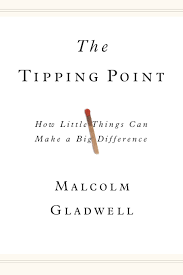#17 - Malcom Gladwell's surprising insight: small changes make a big difference
a OGT from Gladwell's first best-selling book, The Tipping Point
Malcolm Gladwell graduated from the University of Toronto in 1984 with aspirations of writing advertising copy.
But the English-born Canuck was apparently not Madison Avenue material— he was turned down by 12 different ad agencies before giving in. After being rejected from graduate school and a fellowship program, Gladwell took the only job he could find: an entry-level writer for The American Spectator, a conservative outpost in Indiana.
Gladwell hustled, learned all he could, and in 1987, his luck turned. He got hired as a reporter for The Washington Post. For the next 10 years (and 10,000 hours) Gladwell transformed himself from a green writer into a seasoned journalist, finally leaving The Post in 1996 for The New Yorker.
In his very first year at The New Yorker, Gladwell wrote two life-changing articles: The Coolhunt—about trend-spotters—and another article on the relationship between New York City crime and epidemics— he called The Tipping Point.
The two articles quickly coalesced into an idea for a book, one that earned Gladwell a one million dollar advance, eventually propelling him to national stardom, and ironically, an advertising guru. He was Mad Man, after all.
On a recent rereading of The Tipping Point, I was struck by its lessons.
Today’s OGT is about the first lesson: focus.
Focus, Band-Aids, and Hope
The underlying insight of The Tipping Point was an analogy: the spread of ideas and the spread of viruses.
The Tipping Point is the biography of an idea, and the idea is very simple. It is that the best way to understand the emergence of fashion trends, the ebb and flow of crime waves…or any number of the other mysterious changes that mark everyday life is to think of them as epidemics. Ideas and products and messages and behaviors spread just like viruses do.
Throughout the book, he tells the stories that vary widely in subject—including New York City crime rates, Hushpuppies, and Sesame Street—to show, not only that little changes can make big differences, but how we can manufacture our own idea epidemics by employing certain strategies.
The first tactic Gladwell calls ‘focus.’
This is the first lesson of the Tipping Point. Starting epidemics requires concentrating resources on a few key areas. The Law of the Few says that Connectors, Mavens, and Salesmen are responsible for starting word-of-mouth epidemics, which means that if you are interested in starting a word-of-mouth epidemic, your resources ought to be solely concentrated on those three groups. No one else matters. “
Gladwell anticipated a criticism about this lesson. That they may think it was a “band-aid” approach. But, as Gladwell says, Band-Aids are disproportionately useful.
A critic looking at these tightly focused, targeted interventions might dismiss them as Band-Aid solutions. But that phrase should not be considered a term of disparagement. The Band-Aid is an inexpensive, convenient, and remarkably versatile solution to an astonishing array of problems… The Band-Aid solution is actually the best kind of solution because it involves solving a problem with the minimum amount of effort and time and cost. We have, of course, an instinctive disdain for this kind of solution because there is something in all of us that feels that true answers to problems have to be comprehensive, that there is virtue in the dogged and indiscriminate application of effort, that slow and steady should win the race. The problem, of course, is that the indiscriminate application of effort is something that is not always possible. There are times when we need a convenient shortcut, a way to make a lot out of a little, and that is what Tipping Points, in the end, are all about.”
Wielding story and research, Gladwell argues for a smarter, more directed approach to change.
Merely by manipulating the size of a group, we can dramatically improve its receptivity to new ideas. By tinkering with the presentation of information, we can significantly improve its stickiness. Simply by finding and reaching those few special people who hold so much social power, we can shape the course of social epidemics.
He ends the book with that hopefulness and enthusiasm to which we’ve become accustomed from Gladwell.
In the end, Tipping Points are a reaffirmation of the potential for change and the power of intelligent action. Look at the world around you. It may seem like an immovable, implacable place. It is not. With the slightest push—in just the right place—it can be tipped.
The OGT
Malcolm Gladwell is one of my heroes. And it’s because of his ability, again and again, to change—or consider changing—my perspective. He does it by showing me new things, or, like Proust said, “by presenting old things in a new way.”
Clear evidence of this ability is the fact that other well-known writers soon used the The Tipping Point insight to write their own books. Seth Godin’s Unleashing The Idea Virus and Chip and Dan Health’s Made To Stick (one of my favorite behavioral books of all time) come to mind.
More evidence: having read the book, you start to notice Tipping Point lessons elsewhere.
One of Marvel’s Stan Lee’s small shifts used The Law of Context— instead of writing Superheroes that were from made up places and inhuman, he made them human (besides their one power), and from, e.g. New York City. NIKE founder Phil Knight used Gladwell’s Law of the Few in the NIKE early days by signing their first athlete, Steve Prefontaine. And it was one Miami Herald reporter, John Huddy (a Maven, in Gladwell speak), that spread Steve Martin’s name to the comedy world.
My own short book, The Easiest Path To Health, uses the Tipping Point Laws.
How about you?
Is there a little change you can make that might make a big difference in your life? A ‘Band Aid’ approach that uses the Few, Stickiness, or Context to shift how it is seen, or how you see it?
Think about it.





